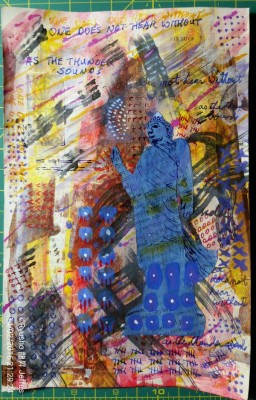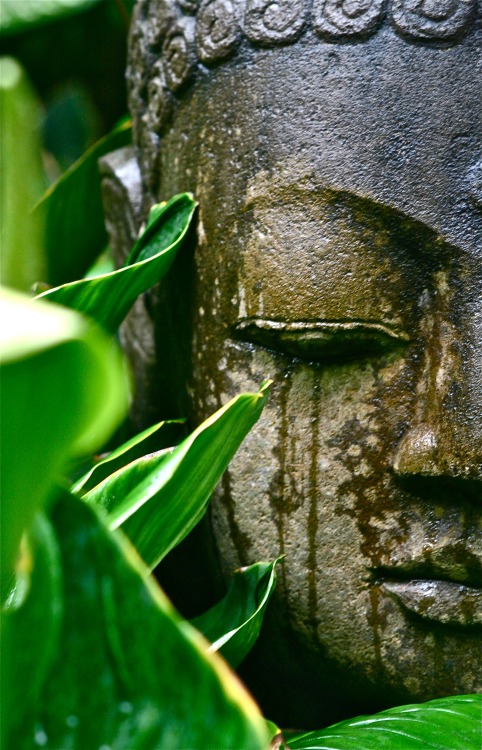 While written specifically about the Lotus Sutra, the questions posed here would be applicable to any endeavor, Buddhism included.
While written specifically about the Lotus Sutra, the questions posed here would be applicable to any endeavor, Buddhism included.
This chapter opens with the Buddha seated in meditation. As I think about this, I am reminded that we all began our practice of Buddhism from some place in our lives. Before our first exposure or our first acceptance, we were living in various ways. We had different approaches and understandings of life. We possibly had different emotional feelings about life in general.
Perhaps we were unhappy, or discouraged, or maybe depressed. Maybe everything was hunky-dory, simply peachy and all that. The point is what was your life like before Buddhism? Try to be as objective as you possibly can be at whatever distance you are from that point in time. Be honest, at least, be honest with yourself, even if not with everyone else.
None of us were blank slates with no prior history, no previous ways of processing life, no prior anything. We each began at a certain point.
The importance of this is to understand better the many ways in which your life has changed. The better you are at articulating this, the better you understand this at a fundamental level in your life. The clearer this is for you to explain the clearer it is at the core of your being. A thing not named is often not understood or considered.
For example, I came to Buddhism in a concrete way while I was in the Marine Corps. The military was the physical environment where I began my practice. The condition of my life, which is more important, was not so good. I was unhappy, I would say miserable. I will not claim I was suicidal; thoughts of suicide had entered my mind, and I entertained them seriously. I felt hopeless. I saw no possible happiness at any point in the near or distant future. I also felt helpless because I had no control over much in my life. I felt the victim. I was 19 and had lived independently for two years. I had been responsible for my food, clothing, shelter, and college education expenses. It wasn’t like I was away from home or family for the first time in my life, as so many in my environment were.
The broad view of my state of being when first introduced to a formal practice of Buddhism was not pleasant. I had studied as much as I could find about Buddhism before this and always felt there was more. What I could not articulate was that the missing pieces were the community of practitioners and the structure of practice. So I am using my first exposure to formal practice and sangha as my beginning point.
If I were to tell my story of the Lotus Sutra, the above would lead up to the opening or introduction chapter of my Lotus Sutra. It would be the first of the Threefold Lotus Sutra of Ryusho’s Life if you wish to call it so.
I can quickly identify these things because I have been working on this intently for a couple of years as well as writing about it in various books. Please take your time. Do not rush into or about this. Hopefully, over time, your story and understanding will evolve. What you identify now may not be the entire picture so be open to further insights and awareness.
Besides the insight this gives you, it also will enable you to articulate clearly to yourself and others where you began and how much you have grown, learned, changed, and benefited due to your faith and practice of the Lotus Sutra.
Sample Questions - in case you’re stuck
What were you doing in your life before?
What was your basic way of responding to events in your life? (Angry, complacent, confrontational, following, leading, directionless)
What were your dreams, aspirations, goals?
What was your frame of mind or emotional condition?
Give a general idea of what the week was like before you ever heard anything about Buddhism, or before you heard about the Lotus Sutra.</blockquote>
The illustration posted in this opening post for this series is an expression of some thoughts and feelings on my pre-Lotus Sutra life. The phrase from the Sutra of Infinite Meanings Sutra about how we can not hear without doing something hooked me. If I had remained in the barracks and never gone to my first sangha meeting, then today would not exist. If I had not been willing to make a commitment to the Lotus Sutra on that first day and on numerous days since then none of this would have happened. In our lives, in our Buddhist practice, in everything we do, something needs to be done, or else nothing happens. Obvious of course, yet is is profound if considered from various perspectives. The Buddha had existed before I was born, and Buddhism has been around longer than I have. The first contact between Buddhism and myself provided me an opportunity to do something to hear the teachings of the Lotus Sutra.
Another phrase that hooked me was "as the thunder sounds". Having lived in various places in my life, I have been able to experience the different sounds of thunder. For the many years, I lived in Hawaii, I missed the thunder, something that is rarely heard on the islands. Growing up in New Orleans we had thunder, it was without echoes and seemed to simply show up and then leave. Here in western North Carolina, the sounds of thunder roll around, returning again and again as if never quite willing to depart. Old tales have used the imagery of bolling-alleys, a not wholly inaccurate description.
The thunder of the Buddha's enlightenment or his first teaching was louder and as expansive as the universe. We might normally be afraid of thunder. The thunder of Buddhism and especially of the Lotus Sutra though is a sweet sound, it is pleasing to hear. It is a sound I have benefited from continually and without measure.
Life can be chaotic and is certainly unpredictable often if not always. Sometimes it repeats endlessly, the same things happen over and over. There are times we wish it would go away, wish it to be different, wish it to be anything other than what it is. The troubles and challenges even at times obscure our ability to see our own lives or the Dharma in our lives. In a way, that is what is going on with all the random weird stuff in this small piece. Or maybe it is simply that right now patterns and doodles are of interest to me. Who knows?
As we work our way along on this project, I may not always show you what I've done. It will depend on what I am inclined to do at that moment. I do envision highlighting or sharing what you all or doing. You don't have to share with me what you've done. I hope you do. If you do, I will not share details about something unless you have given me your permission. Remember it does not need to be just drawing or painting. How about a quilt with one panel for each chapter, or maybe you could knit a pair of crazy socks for each chapter. It can be anything that is your expression of the Lotus in your life.
